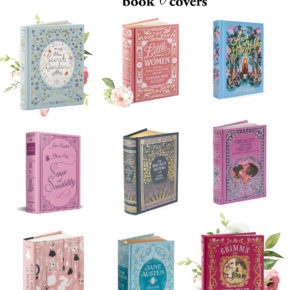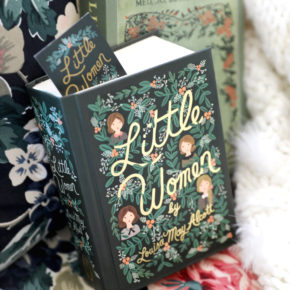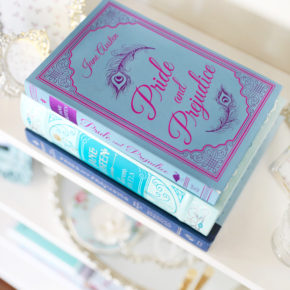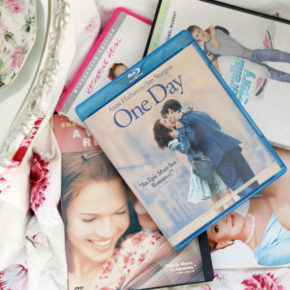Hello Kindred Spirits! For our closing book club discussion on Little Women, I’m thrilled to invite Jenne Bergstrom & Miko Osada, authors of The Little Women Cookbook to join us! This cookbook is filled with wonderful recipes inspired by each of the March sisters and their friends. Today Jenne & Miko will be sharing their process behind writing the cookbook and even giving a lucky kindred spirit the chance to win a copy. Let’s give them a warm welcome!

Meet Jenne & Miko, authors of The Little Women Cookbook!
Welcome! Our community is pleased to meet you. Please introduce yourselves!
Miko: Salutations! My name is Miko Osada. I’m not outwardly very fancy, but I have an inner part of me that glories in tea parties, vintage book covers, and rosebud spray patterns, so I am delighted to be invited to this club. A little about me: I am a librarian for kids and teens, in a suburb just east of San Diego. I love food but I enjoy eating more than cooking. My favorite books include a lot of titles on the Enchanted Life reading list, and the March sister I relate to most is Amy.
Jenne: I’m Jenne Bergstrom and I’m also a librarian from San Diego! My parents ran a summer camp, but as a kid I entirely missed the outdoorsy gene and spent all my time reading. In spite of this fact, I became a librarian more because I love working with people and having interesting experiences than because I love books. When I’m not at work I like trying new foods and doing projects with friends and having small weird adventures.
Together, we started a blog called 36 Eggs, for which we re-create dishes from memorable literary scenes. The project was named in honor of the famous Pringle pound cake from Anne of Windy Poplars.
When was the first time you read Little Women and how did it impact you?
Miko: I first got to know Little Women in Japanese. Little Women is widely read in Japan — it really speaks to the international appeal of the story. I listened to my mom read it aloud at bedtime, and I had an abridged Japanese picture book that I loved. I read it in both Japanese and English when I was in 4th grade, and I’ve read it at least once a year ever since — I’d guess I’ve read it 30+ times.
I think Little Women became an enduring favorite for me because I related to how much the sisters struggled to be good people. Up until Little Women, the books I read tended to have heroes that were naturally good and villains that were inherently evil. I felt comforted that the Marches had to put in a lot of effort to overcome their everyday faults and deal with awkward social situations. I got the message from them that it’s normal and okay to be a work in progress.
Jenne: I’m not quite sure how old I was…8? 10?, but two of the former staff from my parents’
camp used to take me out for a fun experience every year for my birthday, and one year they gave me a copy of Little Women. It was this edition (my copy is much more tattered than this but it’s at my mom’s house and not available for a photo op).
I can’t really remember the actual first time I read it, because I reread it so many times. I loved stories about people’s real lives in the past, how they did everyday things and were not so different from me. I was fascinated by the descriptions of clothes and food and household chores … and of course the romances! I read a lot of her other books as well, like An Old Fashioned Girl and Jack and Jill, and I wish they were more well-known; they’re a lot of fun.
When did you know you wanted to write The Little Women Cookbook?
Jenne: We didn’t know until it happened! We started our 36 Eggs blog because we’d always wanted to eat the food from the novels we read, especially the ones we read as kids. We didn’t really expect anyone to read it beyond our friends and family, but when you do something extremely niche like recreate Jo’s disastrous dinner party from Little Women, there are like-minded people who will find you….
…such as an editor from Ulysses Press! She was thinking it would be a good idea to publish a Little Women cookbook to go along with the 2019 movie release, so she searched around for any bloggers who had done LW recipes and found us.
We weren’t entirely sure we knew how to write a literary cookbook, but as we thought about it we decided that we were probably some of the most qualified people around–we are librarians who are used to doing research; we have a lot of experience recreating historical recipes; we already have a number of contacts with culinary historians; and we are both longtime fans of Louisa May Alcott and quote Little Women to each other all the time. If not us, who?
Neither of us had really ever thought of publishing a book, but as librarians we feel we’ve achieved a dream we didn’t know we had–seeing our own book on the shelf in our library. It’s so beautiful!
What kind of research was involved in writing the cookbook? How did you decide to categorize the recipes by character?
Miko: In our writing partnership, Jenne is usually the chef and photographer, and I’m generally the researcher. I get obsessed. When we were first approached to do the cookbook, I spent the weekend re-reading the novel and noting every single food and drink that appeared in a spreadsheet.
When Jenne and I take on literary food projects, our goal is to make them true to the source material. I’ve never wanted fan cookbooks with recipes that are inspired by a story; I want the food that is from that story. I spent a lot of time as a kid wishing I was living in my favorite books, and having the exact meal from a scene is a multi-sensory way to transport yourself into fiction.
With a story like Little Women that takes place and was written in the 19th century, getting authentic meant that we had to do a lot of historical research. We wanted all of our recipes to be based on actual dishes and beverages from cookbooks of the era. A seemingly insignificant question (like “What kind of tea did the March girls drink?”) would send me to the nearest university library for hours to find the answer.
Once I had laid out the list of possible dishes, it became clear to us that the only way we could organize the book was by character. That was how we as readers connected so strongly to the story — through getting to know each one of the sisters. The food and drinks they made and enjoyed tell us a lot about their personalities and priorities.
If you could recommend only one treat or meal from the cookbook, what would it be and why?
Jenne: All of the ice creams! The rose and almond one is especially unusual and lovely; it’s a flavor combination you’ve probably never had before. And I say this all the time: the asparagus toast (p. 53) sounds incredibly weird when you read the recipe, but it’s really really good. Basically you cook asparagus to what modern tastes would say was extremely overdone, then dip toast in the cooking water, butter the wet toast, and lay the asparagus on top. I recently made a whole dinner from the cookbook for some friends, and the asparagus was everyone’s favorite dish, even over the Charlotte Russe!
Miko: I would second the asparagus. Some of our experiments with Victorian recipes were more successful than others. We both expected the asparagus toast to be totally inedible; I actually laughed out loud when I read the instructions. But we were too curious to see how it would turn out … and it’s kind of like a savory bread pudding!
To keep up with Jenne & Miko and their literary-inspired recipes, visit their blog at: 36eggs.com and Instagram at: @36eggs | Get your own copy of The Little Women Cookbook here.
GIVEAWAY TIME!












Leave a Reply